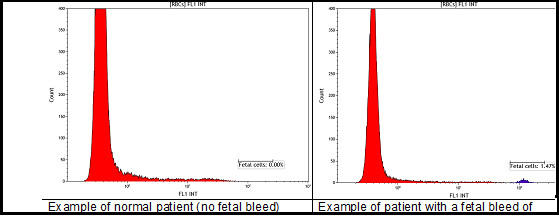Fetal Hemoglobin Detection by Flow Cytometry
Clinical Significance:
Measurement of fetal cells has traditionally been performed based on the Kleihauer-Betke technique. This is a slide-based microscopic counting method of blood smears, which is laborious and suffers from lack of sensitivity (0.5% Fetal cells, approximately 25ml fetal bleed), subjectivity and precision (CV 50-100%).
Flow cytometry is capable of both high sensitivity of detection (0.01%) and rapid cell-by-cell analysis. Using antibodies to HbF allows for a broad application to various clinical situations. Moreover, the quantitative nature of flow cytometric analysis permits the distinction of true fetal cells, which contain HbF as the major form of Hb, from maternal circulating F-cells that have lower cellular HbF content. This is particularly applicable for individuals with hereditary persistence of HbF or various hemoglobinopathies.
The flow cytometric method for the assessment of fetal-maternal hemorrhage (FMH) is based on the detection of HbF positive fetal cells in order to:
- determine the dosage of Rh immune globulin required to prevent Rh sensitization of an Rh negative mother
- evaluate possible trauma to fetus through amniocentesis, manipulation, fall, abdominal trauma, etc. (Rh-positive or Rh-negative mother)
- investigation of anemias

Who should be tested?
Patients with suspected fetal-maternal hemorrhage
Specimens:
Peripheral Blood in EDTA or heparin (4°C). Specimens should ideally be collected within one hour of delivery and sent to the lab ASAP. Testing can be performed up to 4 days after collection.
Transport: Via Uniship Courier Service
CPT Code: 88184
Test performed: Monday through Saturday
Test reported: Faxed or mailed within 24 hours after sample is received.
